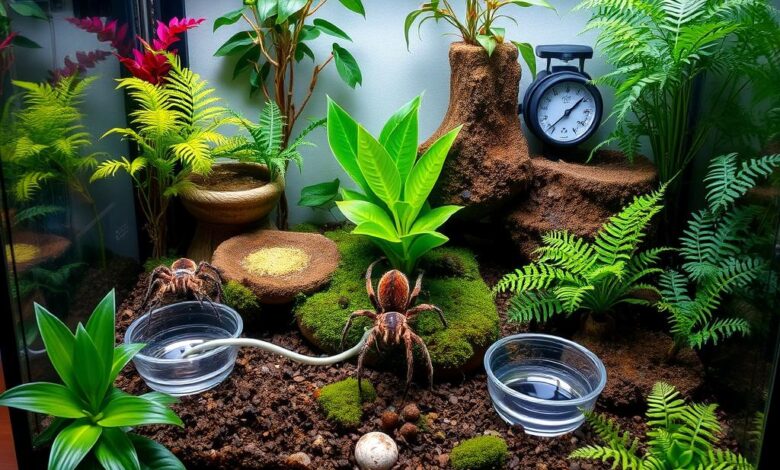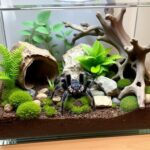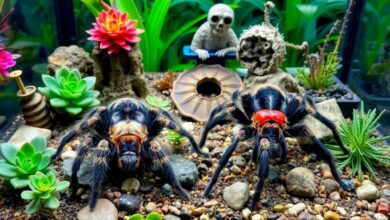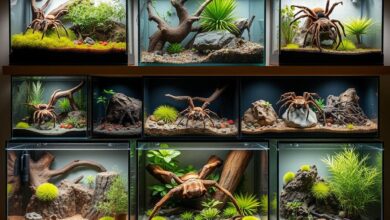Techniques to maintain adequate humidity in the terrarium according to the species of tarantula

Keeping the right humidity levels in a tarantula’s terrarium is key for their health. Different tarantulas need different humidity levels based on where they come from. This article will show you how to keep the humidity levels right for your tarantula’s home.
It doesn’t matter if you have a terrestrial or arboreal tarantula, or if they live in the tropics or the desert. The right humidity levels are crucial for their life and health. By knowing what your tarantula likes, you can make a perfect terrarium setup for them.
Understanding Tarantula Species and Their Humidity Requirements
When caring for tarantulas, knowing their humidity needs is key. Tarantulas are either terrestrial or arboreal. Each type has its own moisture preference.
Terrestrial vs. Arboreal Tarantulas
Terrestrial tarantulas, like the Chaco Golden Knee (Grammostola pulchripes), need more humidity. They live in tropical or subtropical areas. On the other hand, arboreal tarantulas, such as the Antilles Pink Toe (Avicularia versicolor), like it dry, just like their tree homes.
Tropical vs. Desert Tarantula Species
Where tarantulas come from affects their humidity needs. Tarantulas from tropical climates, like the Goliath Bird-Eating Spider (Theraphosa blondi), need more humidity. Desert tarantulas, such as the Arizona Blonde Tarantula (Aphonopelma chalcodes), prefer less moisture.

Knowing the habitat preferences and humidity needs of your tarantula is vital. The right moisture level keeps your tarantula healthy and happy.
Monitoring and Regulating Humidity Levels
Keeping an eye on the humidity levels in a tarantula’s terrarium is key. Hygrometers and humidity gauges are vital for checking the relative humidity. They help you adjust the humidity to the right level. For most tarantulas, this is between 60-80% for ground-dwelling ones and 40-60% for tree-dwellers. Checking the humidity often and keeping track of the readings lets you fix any issues quickly.
Using Hygrometers and Humidity Gauges
Hygrometers and humidity gauges are crucial for monitoring the humidity in your tarantula’s home. They give you exact readings of the relative humidity. This helps you keep the humidity just right for your tarantula’s health. By placing these tools in the right spots, you can make sure the humidity is always where it should be.
- Hygrometers: These are either digital or analog tools that show the relative humidity in the air. They give you a precise look at the moisture level.
- Humidity Gauges: These are analog devices that show the humidity levels with a visual display. They make it easy to see the moisture level at a glance.

By regularly checking and recording the humidity with these tools, you can spot any changes. This is key for making the right changes to keep your tarantula’s environment perfect for its health.
Water Dishes and Humidity Maintenance
Adding water dishes or pools to a tarantula’s terrarium helps keep the right humidity levels. As water evaporates, it makes the air more moist. This helps fight dry air or low humidity. It’s important to check the water level often and add more when needed. Make sure the substrate stays damp but not soaked.
Where you put the water dish matters a lot. Think about air flow and substrate depth. For best results, place it in a quiet spot with good air movement. This helps with evaporation and condensation, keeping the terrarium’s humidity just right.
It’s key to keep an eye on the water level and substrate moisture. Doing this helps keep the tarantula’s home at the right humidity levels. With these easy steps, tarantula lovers can make a great home for their pets.
 The best substrates for different species of tarantulas
The best substrates for different species of tarantulas
Humidity Maintenance with Substrate Choices
The substrate in a tarantula’s terrarium is key to humidity regulation. Substrates like coconut fiber, sphagnum moss, and topsoil mixes are great for keeping moisture in. They soak up and slowly release water, keeping the terrarium’s humidity steady. It’s important to pick the right substrate for your tarantula’s needs.
Coconut Fiber, Sphagnum Moss, and Topsoil Mixes
Coconut fiber is a top choice for many tarantulas because it holds a lot of moisture and releases it slowly. Sphagnum moss is also great, absorbing water and keeping humidity steady. Topsoil mixes blended with other materials also help with moisture retention and humidity regulation.
When picking a substrate, think about what your tarantula needs. Terrestrial tarantulas need a thick layer of substrate to keep moisture in. Arboreal tarantulas prefer a shallower layer. Always check the humidity and adjust the substrate as needed to keep your tarantula healthy.
Choosing the right substrate and keeping the right moisture levels helps create a great environment for tarantulas. This ensures they thrive in their humidity-controlled home.
Applying Proper Ventilation Techniques
Good terrarium ventilation is key for keeping the right humidity level in a tarantula’s home. It helps avoid too much moisture, which can cause mold or fungus. As a tarantula owner, you need to balance air exchange with the humidity your tarantula likes. Adjust ventilation based on your tarantula’s needs.
Putting air vents in the terrarium is a smart move. They help keep air moving in and out, making sure old air is replaced with fresh air. You can also use fans to help with airflow management and stop condensation. Automated systems are another choice, making it easy to keep humidity right in the terrarium.
The aim is to keep the right humidity for your tarantula’s health and comfort. At the same time, stop too much moisture from building up. By getting good at terrarium ventilation, you can give your tarantula the best home possible.
| Ventilation Technique | Description | Benefits |
|---|---|---|
| Air Vents | Strategically placed openings that allow for controlled air exchange | Facilitates consistent humidity regulation and prevents condensation prevention |
| Fans | Mechanical devices that promote airflow management within the enclosure | Enhances air exchange and helps maintain optimal humidity levels |
| Automated Systems | Advanced ventilation solutions with programmable controls | Provides reliable and efficient humidity regulation without constant monitoring |
Misting Systems and Humidity Control
Adding misting systems to a tarantula’s terrarium helps manage humidity levels. Automated misting systems use timers or sensors for a steady, hands-off way to control humidity regulation. On the other hand, manual misting lets you spray the enclosure as needed, giving you control over how often and how much to mist.
Automated Misting Systems vs. Manual Misting
Choosing between automated misting systems and manual misting depends on the tarantula type and what the caregiver likes and can do. Automated systems give a steady water delivery and humidity control. Manual misting lets you adjust based on the tarantula’s needs and what you see.
- Automated misting systems are good for those with little time or who want a steady humidity level. They work well without much effort from you.
- Manual misting gives you more control and flexibility. You can change the misting based on the tarantula’s needs and the environment.
The choice between automated misting systems and manual misting depends on the tarantula type, what you prefer, and the terrarium’s needs.
Humidity Maintenance for Molting Tarantulas
During the important process of molting, tarantulas need a lot of humidity. This helps them shed their old skin easily. Keeping the humidity right, about 80-90%, is key to a smooth molt without problems.
People who keep tarantulas should watch for signs they might molt soon. They should also use methods to increase humidity. This can mean making the ground in their home more moist or changing their home to keep in more humidity.
- Look for signs your tarantula might molt, like eating less and being less active.
- Make the ground in their home more moist to keep humidity at an 80-90% level during molting.
- Think about using a special humidity box or misting their home more often to keep it humid.
- Don’t bother your tarantula while it’s molting. This can mess up the process.
Keeping the right humidity helps tarantulas molt well. This means they grow and get healthier.
| Tarantula Species | Ideal Humidity Range | Substrate Recommendation |
|---|---|---|
| Terrestrial Tarantulas | 70-80% | Coco coir, sphagnum moss, or a mix of topsoil and sand |
| Arboreal Tarantulas | 80-90% | Sphagnum moss or a mix of coco coir and cypress mulch |
Dehumidifiers and Air Conditioning for Humidity Control
When natural methods don’t work, dehumidifiers and air conditioning can help keep moisture levels right in a tarantula’s home. Dehumidifiers take out extra moisture, and air conditioners control temperature and humidity. It’s important to pick and use these devices right, making sure they don’t dry out the space too much and keep the humidity at the right level for the tarantula.
 The ideal materials for building a safe and durable terrarium
The ideal materials for building a safe and durable terrarium
A new partnership between Shipshape and Santa Fe aims to make systems work better, send alerts, and save energy. This comes as the Inflation Reduction Act promotes saving energy at home. Now, customers can get Shipshape’s Dehumidifier Upgrade Solution with features like AlertActions™, Home Assistant Monitoring™, and Shipshape Assisted Maintenance (SAM™).
Santa Fe has been a leader in air quality and innovation for over 30 years. They focus on saving energy and making customers happy with their dehumidifiers. Keeping humidity between 30-50% with a dehumidifier stops mold from growing and coming back after cleaning. Experts and the EPA say this humidity range is best for tarantulas and their owners.
| Product | Features | Recommended For |
|---|---|---|
| ThermoPro TP50 Digital Hygrometer | Affordable, accurate humidity monitoring | Monitoring humidity levels in the home |
| Honeywell 30 Pint Energy Star Smart Dehumidifier | High capacity, built-in app for easy control | Spaces up to 1,000 square feet |
| hOmeLabs 50-Pint Dehumidifier | Compact size, efficient, effective | Maintaining low moisture levels |
| Frigidaire Gallery 50-Pint Dehumidifier with WiFi | Dehumidifying capabilities, smart features | Large homes with high humidity |
| hOmelabs 4000 Sq. Ft. Dehumidifier with Pump | Hands-free emptying with drain hose | Spaces up to 4,000 square feet |
It’s important to use dehumidifiers and air conditioning right and with air purifiers for better air quality. By picking and using these devices carefully, tarantula owners can keep the right humidity levels for their pets. This makes a healthy and happy home for them.
Troubleshooting High and Low Humidity Issues
Keeping the right humidity level is key for your tarantula’s health. But, sometimes, you might face issues with too much or too little humidity in the terrarium. Spotting signs of wrong humidity levels is the first step to fix the problem and make a healthy home for your pet.
Signs of Improper Humidity Levels
There are clear signs that show your tarantula’s home might have High Humidity or Low Humidity issues:
- Excessive condensation on the terrarium walls or substrate
- Mold or fungal growth
- Lethargy or sluggish behavior in your tarantula
- Changes in the tarantula’s appearance, such as a dull or discolored exoskeleton
- Difficulty in molting or shedding its exoskeleton
- Signs of dehydration, such as a shriveled or wrinkled appearance
If you see any of these Signs of Improper Humidity, you need to act fast. Fixing the Humidity Imbalance is key to keeping your tarantula healthy and happy.
Humidity Maintenance and Its Impact on Tarantula Health
Keeping the right humidity in a tarantula’s home is key to their health. It helps them stay hydrated, go through molting easily, and stay healthy. The right humidity level is important for tarantulas to live well.
By keeping an eye on the humidity, we can make a great home for tarantulas. This helps them behave naturally, stay healthy, and live longer. Taking care of humidity maintenance is a big part of being a good tarantula owner.
Too much or too little humidity can harm tarantulas. This can cause:
- Dehydration and poor health
- Hard molting
- More chance of humidity-related diseases
But, the right Proper Humidity Levels are good for tarantulas. They help with:
- Good hydration and Tarantula Welfare
- Easier and less stressful molting
- Less chance of Environmental Conditions causing health issues
Knowing what humidity each tarantula needs is important. Taking care of the Environmental Conditions in their home helps them live a long, healthy life.
| Humidity-Related Diseases | Symptoms | Prevention |
|---|---|---|
| Dehydration | Lethargy, loss of appetite, shriveled appearance | Maintain proper humidity levels, provide water sources |
| Mold and Fungal Infections | White or discolored patches on the body, lethargy | Ensure adequate ventilation, avoid overwatering |
| Respiratory Issues | Wheezing, difficulty breathing | Maintain humidity within species-specific range |
Conclusion
Keeping the right Humidity Maintenance levels in a tarantula’s terrarium is key to good Tarantula Care. Knowing the Humidity Requirements of each tarantula species helps. Using Humidity Regulation Techniques and watching for problems creates the best Environmental Conditions for their health and happiness. Taking care of Humidity Maintenance is important for these amazing arachnids to live well.
The Terrarium Setup and keeping an eye on Humidity Levels are vital for Tarantula Health. By learning from this article, you can give your tarantulas the best Environmental Conditions. This lets them live their lives fully and show off their unique traits.
Putting effort into Humidity Maintenance in a tarantula’s home makes them healthy, lively, and happy. By focusing on this part of Tarantula Care, you help your tarantulas live a long and rewarding life. This makes tarantula-keeping a successful and fulfilling hobby.
 Ideas and tips for decorating a terrarium in a safe and attractive way for a tarantula
Ideas and tips for decorating a terrarium in a safe and attractive way for a tarantula



